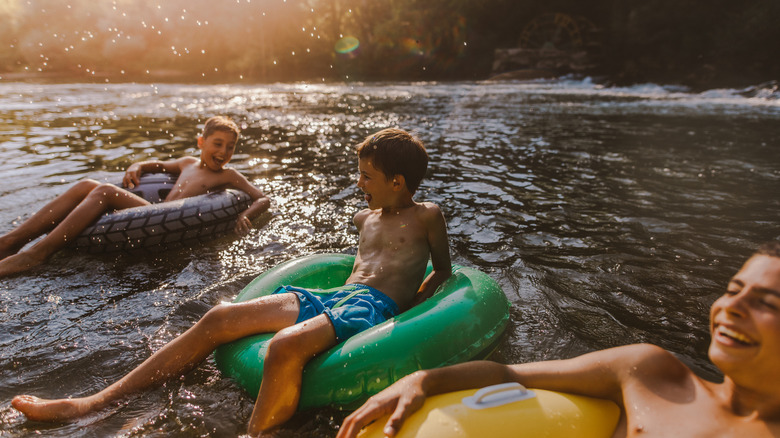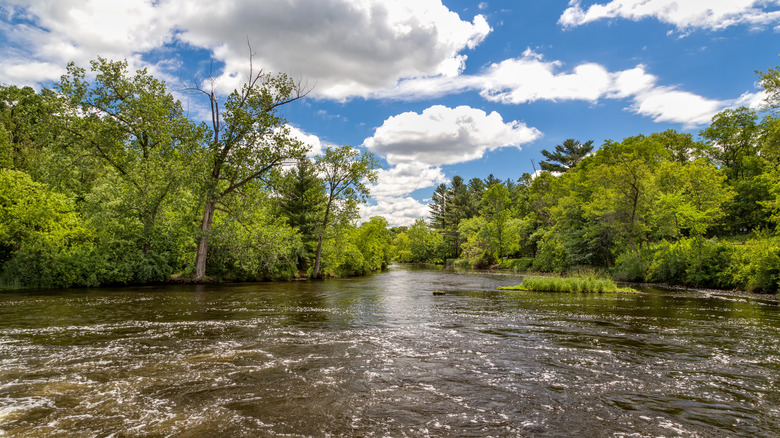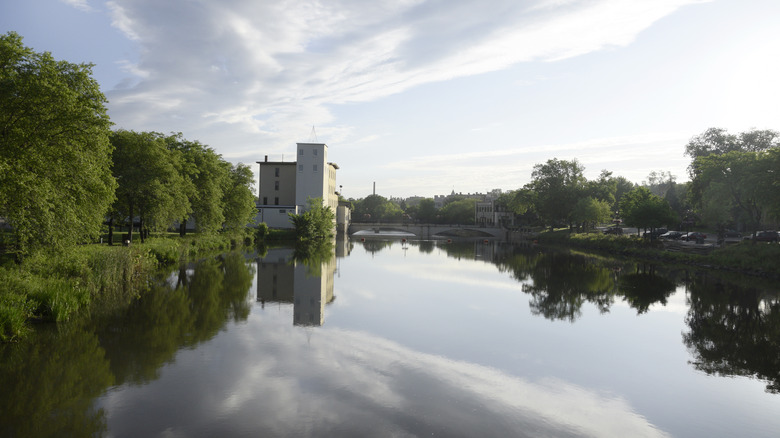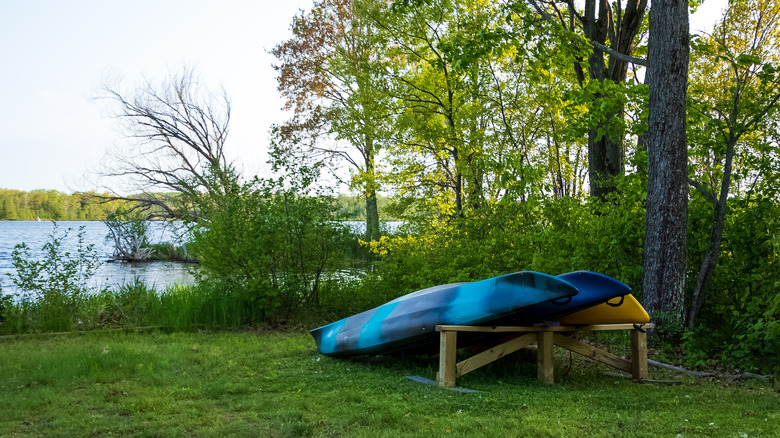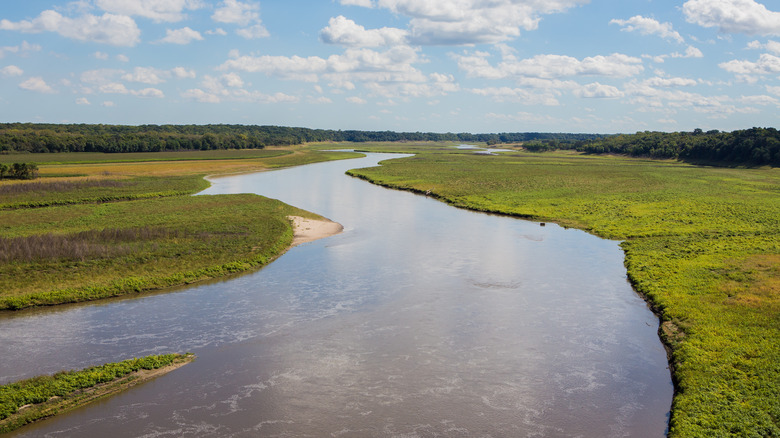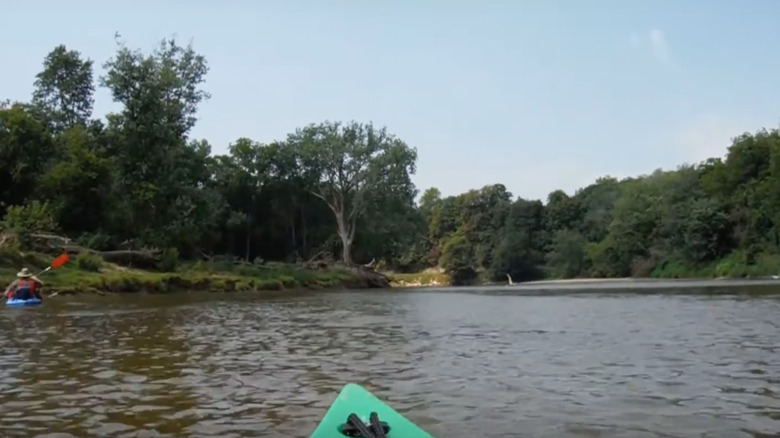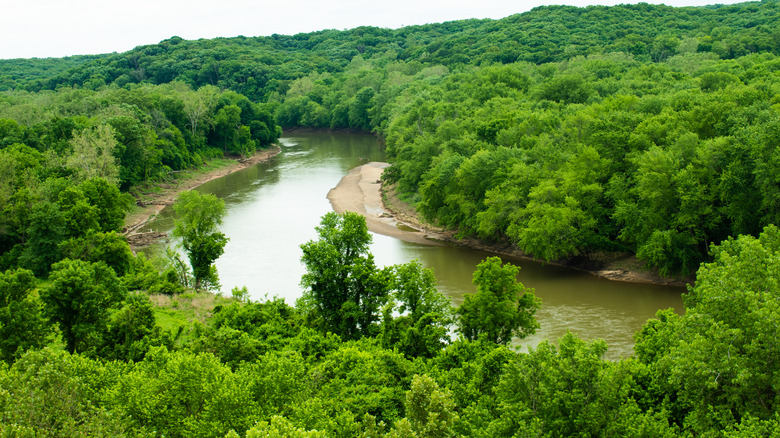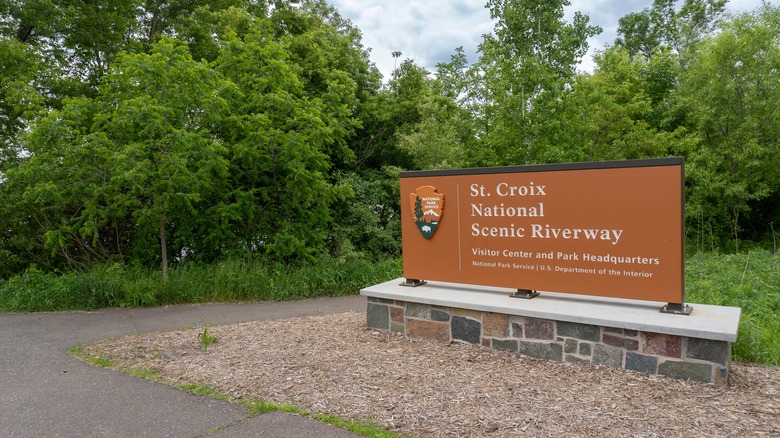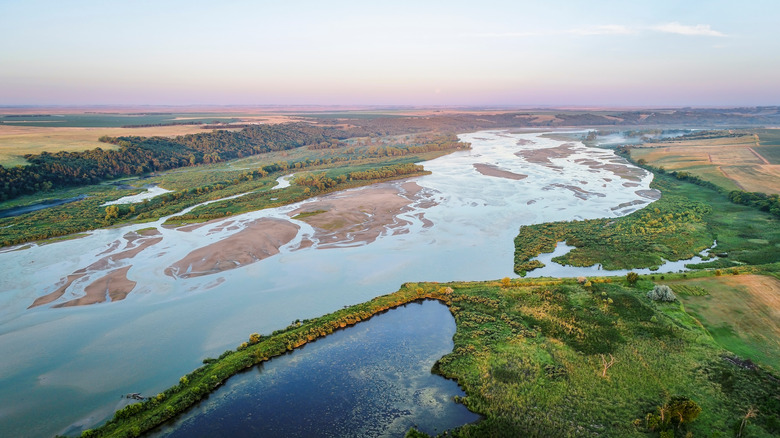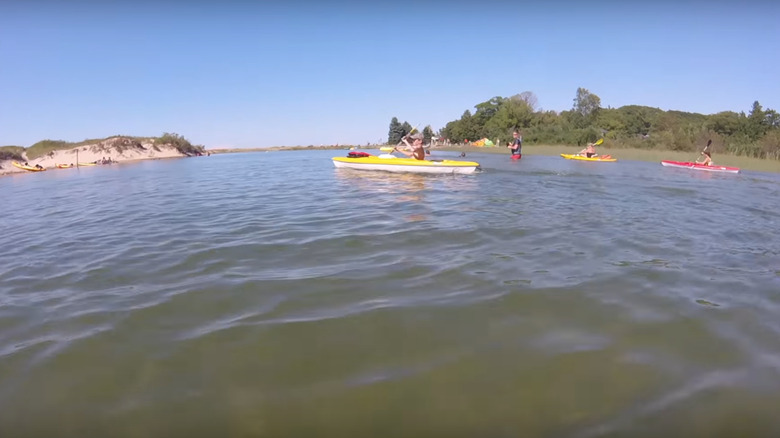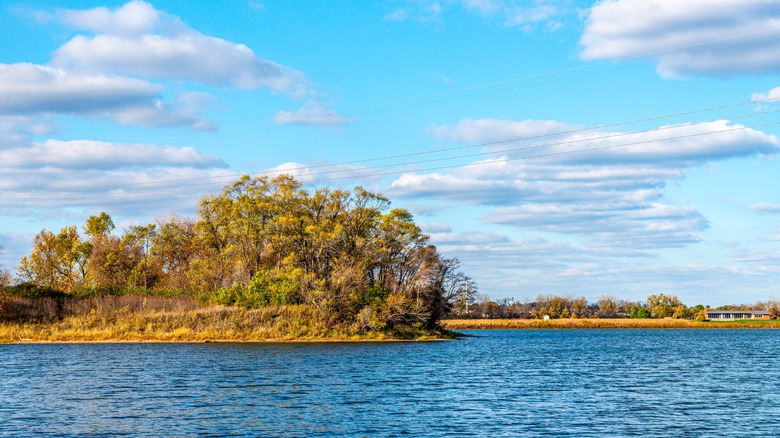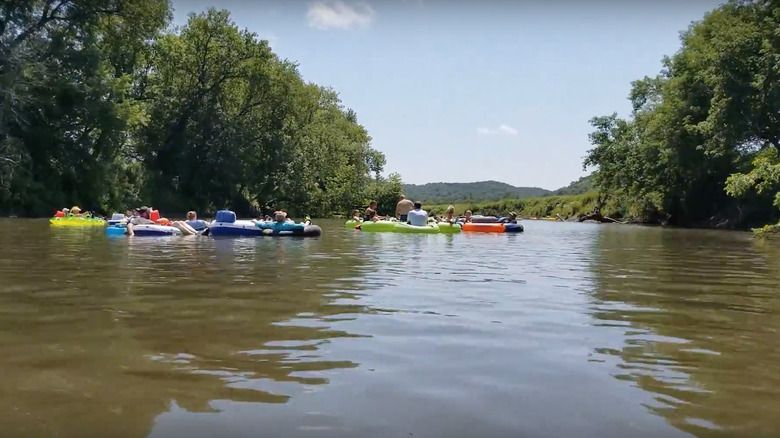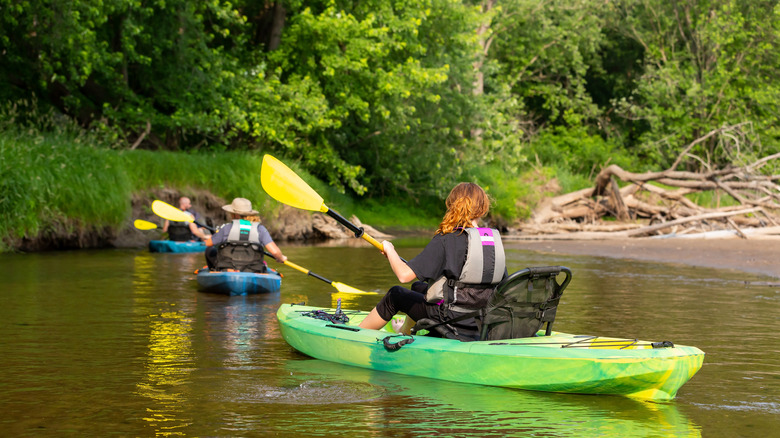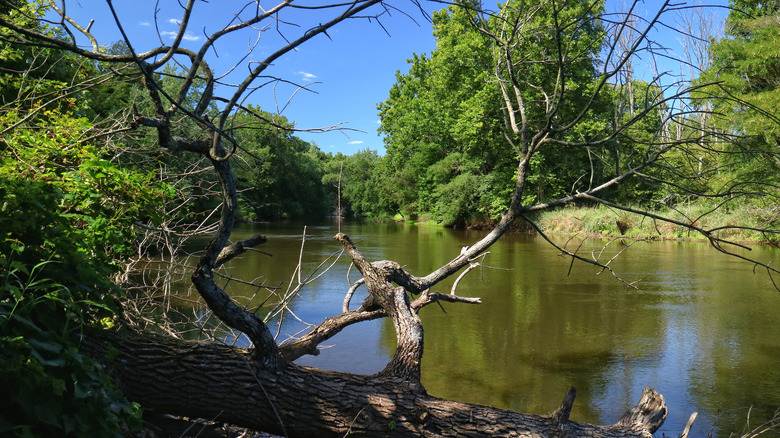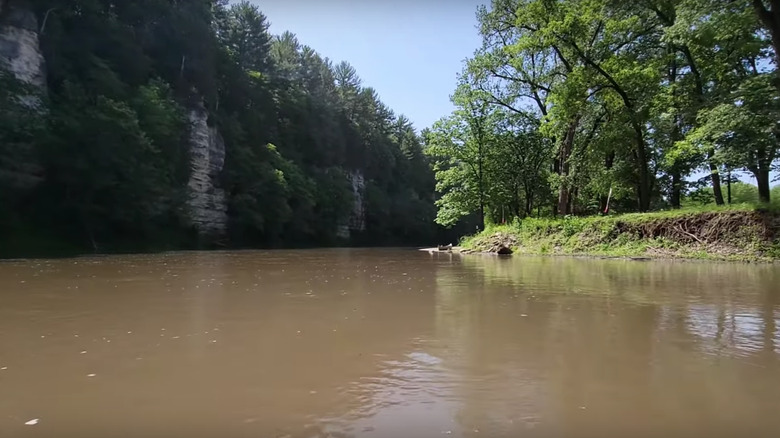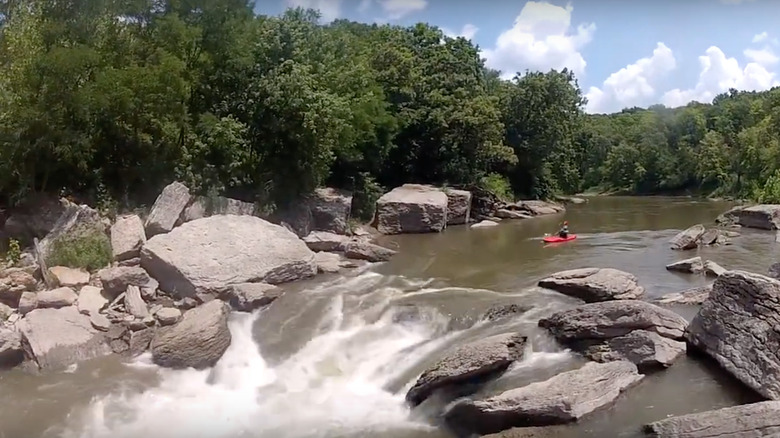Best Midwest Rivers For Floating And Tubing Day Trips
A lasting memory of summer is time spent by, on, or in the water: trips to the beach for swimming or snorkeling; visits to the lake for boating, fishing, or sunset views; and of course, excursions to the river for the most relaxing of activities — tubing or floating. Floating is a classic lazy summer pursuit — an adventure that combines the elements that make this season such a joy: the warmth of the air and water (though some rivers remain brisk, even during the summer), the long days that stretch far into the night, the sense of not having to watch the clock, and the gradual acceptance that it's okay to relax, kick back, and let nature dictate where you'll be going and when precisely you'll get there.
There are great places to float all over the United States that will let you enjoy the great outdoors with few distractions and little exertion. The Midwest has some particularly special river options for floating and tubing. Here are some worth checking out.
Apple River
A short distance east of Minneapolis, but across the border in Wisconsin, the Apple River offers a great introduction to the low-impact, high-relaxation world of tubing. Campgrounds are also offered at many of the tubing facilities on the river. River's Edge is a company in New Richmond that offers campsites on the Apple River, and even cabins that are air-conditioned! Of course, River's Edge also rents out tubes and more for merrymaking on the water.
With more than 3 miles of water to float along, travelers can zone out and take in the scenery, and children as young as five can join in the activity. For a group outing, consider renting a 500-gallon tank (normally used to hold drinking water for cattle) that can hold up to six people and comes with paddles and even a bench to sit down on. Close by, in Somerset, Apple River Family Campground has a similar offering, where tubing trips can last up to 150 minutes as you glide along serene waters flanked by trees.
Cannon River
Falling under the Cannon River State Water Trail, this Minnesota waterway (which forms a natural border with Wisconsin) is generally a calm thoroughfare, with access points at various stops along its route. There are some minor rapids along the way, though nothing more testing than a Class I, which is described as easy, light ripples, smooth water, and gentle curves. Kayaking, canoeing, and tubing are also viable options for the whole family.
Look forward to an abundance of wildlife along the way, with the chance to see bald eagles and herons scouring the water and terrain for possible prey. As for flora, the endangered dwarf trout lily, which only grows in a trio of counties in the south of Minnesota and nowhere else on planet, can be spotted while floating down the Cannon River. Seeing one is a real treat, a delicate flower with slender purple-tinged petals that seem to flare upwards, almost like an inverted umbrella.
Chippewa River (Michigan)
Book a tube or kayak with Chippewa River Outfitters, and soon you'll appreciate the simple things in life. Not to be confused with the Chippewa River in Wisconsin, the gentle flow of this Michigan river will help you forget all your worries. Without any waves or even the slightest hint of turbulent water, a trip down this river will be stress-free, as you quietly glide along at about 4 mph (the average speed of a brisk walk). The operator can even arrange for a trip that stretches into the afternoon, for groups that want to make a full-day event out of the excursion.
This float spot is about two-and-a-half hours northwest of Detroit and can be easily arranged as a day trip. The river itself is a shade over 90 miles in length and works its way through a variety of environments, including parcels of farmland, different towns and cities, and also through tranquil, natural spaces of woods, where the sounds of birds chirping might be the only thing you'll hear.
Des Moines River
A number of sections along the Des Moines River (that slices through the Iowa city bearing the same name) offers rewarding floats. The river itself is mammoth, stretching more than 500 miles from one end to the other and widening to 200 feet across at points. The long section from Emmetsburg to Rutland is pure natural bliss, with birds and otters as company as you pass under bridges along the way. Some parts of the river travel through wooded patches, and deer sometimes come down to the shore to quench their thirst.
Northwest of Des Moines, in Boone, tour operator Seven Oaks takes fun seekers out on the water. Make sure you check the website, though, as low water levels can put a temporary hold on the company's water operations. When the river is full enough, a tubing trip can last up to five hours as you travel about 7 miles, with sandbars along the way supplying places to stop. For train lovers, gliding below the Kate Shelley High Bridge is a highlight, set more than 180 feet overhead and used by trains around the clock.
Maquoketa River
Enjoy Iowa's rural splendor along the Maquoketa River, part of a water trail that has a rich variety of landscapes along the way. While gently rumbling along the Maquoketa, tubers and kayakers will find themselves looking at cliffs made of limestone (a remnant of geological processes from millions of years ago), forests filled with grand oak trees, and tracts of farmland and urban sprawl. During a float, when there is nobody around and the rocks and trees look like they might have done for millennia, the trip can feel like a voyage back in time, to an era where life was more connected to nature.
There is plenty of wildlife to observe along the river, and visitors might hear birds before seeing them, particularly of woodpeckers that live in the woods along the banks. One of the most scenic parts of the river is at Backbone Lake, where the spires of limestone above the water are breathtaking; for an added thrill, you can hike the trail above the cliffs.
Meramec River
Southwest of St. Louis, Meramec State Park has long drawn outdoorsy people for its hiking trails, camping facilities, and a chance to hit the water for some fishing and boating. The park itself spreads over almost 7,000 acres, with a healthy stock of pine trees bringing a fresh fragrance to the air. The Meramec River flows through the heart of the park, and its tame waters make it a great choice for families in search of a serene float.
While there are some Class II bits along its path (classified as medium-quick water, rapids with regular waves, and some maneuvering required), the river is really a breezy experience. It offers fabulous natural sights, with caves, natural springs, and even tall limestone formations along the riverbank, while trees flanking the river add some calming greenery to the experience. Visitors to the area should also stop by Meramec Caverns, a brilliant complex of chambers underground, including the famous Stage Curtain, a series of rock formations that rise 70 feet in height and mimic a set of theatrical curtains.
Namekagon River
The Namekagon River is part of the St. Croix Scenic National Riverway, which straddles both Minnesota and Wisconsin. Namekagon is a gentle waterway in Wisconsin that promises lazy trips in glorious environments. The lower part of the river, sandwiched between the towns of Danbury and Trego, are some of the calmest, with hypnotically serene waters and no chutes, slides, or rapids to contend with. Floats here can easily be full-day affairs as the river carries you to areas that feel like the great wilderness, with no modern development in sight.
That said, the imprint of humankind will be evident along the way. At one point, the river slices beneath a state highway. Fishermen prize this stretch of the river for the chance to catch bass and walleye, and some also enjoy spying the painted turtles that hang out from their riverside perch. Paddlers will be able to see wetlands, towering bluffs, and soaring pine trees that sometimes offer patches of shade at the edges of the river.
Niobrara National Scenic River
While summer is the peak season to float down this piece of Nebraska, spring and fall are also incredibly gratifying. Visitors here arrive knowing that, for the vast majority, the few hours of skimming along the river is the main attraction. As such, the stream does get busy during the warmer months — the most packed day is usually Saturdays, when partygoers can often be present. A number of local operators are equipped to take visitors out for trips here.
For family groups, a fun option is the four-person tube offered by Brewers Canoers & Tubers, which looks like a cross between a pool mattress and a couch; the company also rents traditional tubes and standard canoes. Dryland Aquatics can set travelers up for tube floats that last four or six hours, stretches of peace guaranteed to put a smile on you face. Also in the area, the Fort Niobrara National Wildlife Refuge has plenty of wildlife on view, including bison, migratory birds, and deer, as well as sections of prairies, forest, and sandy dunes.
Platte River
Set within the Sleeping Bear Dunes National Lakeshore in Michigan, the Platte River has some placid places to cool off on a sweltering days. Locals laud the chance to escape daily life with a float down a waterway that is clean, clear, generally shallow, and easy to navigate, not disturbed by rocky patches or rapids of any sort. There are long and short trips here, and one particularly easy option that requires minimal effort — a loop, of sorts, between the Platte River Picnic area to Kittendorf Landing near Loon Lake, a section that takes about an hour to gently glide along.
For a longer excursion, consider putting your flotation device in the water at Fish Weir, also close to Loon Lake. This will bring you almost all the way to the mouth of the river, where it empties into Lake Michigan. It's an exciting way to trace the final part of the river's life.
Raccoon River
Part of a riverine network in Iowa, Racoon River provides some great summer floats. The North Raccoon River Water Trail, which links up with the Des Moines River, spreads over 180 miles of waterway, giving travelers the opportunity to cover plenty of different aquatic areas. There are a number of launch points along the river to meet your specific needs — some are boat ramps, while others are simple access points. You can certainly take to the water on your own vessel, but outfitters in the region aren't hard to locate.
Raccoon River Excursions has been servicing trips on the waterway for more than a decade, with floats that can last up to seven hours, though four or five hours is the average, and launches at 10 a.m. and noon. Tubing trips are held on weekends and include a cooler (one for every five people), for those that like a little liquid refreshment with their liquid adventures.
Root River
In the southeast of Minnesota, Root River has no real rapids, making it a smart choice for families with young kids who want to enjoy a relaxing float. Its flow is constant — gentle enough so as not to disturb anyone riding it, but strong enough to ensure that the scenery renews itself regularly. A number of springs inject new sources of water into the river as its works its way past lofty rock formations that support hickory and oak trees. In other parts, the view transforms into dairy farms and hills that rise and fall along the horizon.
The waters are nutrient-rich, home to bass, sunfish, and more, with colder parts also populated with trout. Birds are commonplace, and hawks and bald eagles co-exist alongside herons and ducks. Other land creatures that might be spotted during a foray along the Root River include foxes, deer, coyotes, woodchucks, and, for the lucky, the timber rattlesnake sometimes makes an appearance along the river's edge.
Rum River
Officially designated as a Wild and Scenic River, and backed by laws that protect and preserve it, the Rum River State Water Trail runs more than 150 miles between Minnesota's stunning Mille Lacs Lake and the Mississippi River. Throughout its extensive journey between those two mighty waterways, it flows in a relatively sedate manner, so anyone looking for a float trip here doesn't need to be an expert on the water.
There is a plethora of wild beauty around the Rum River, with maple and ash trees creating verdant river banks, and bald eagles and deer among the fauna that call this part of the country home. Landscape variety is one of the key attractions: Marshland, farming tracts, and vast plains are just some of the sights visitors can anticipate. One of the calmest sections is between Milaca and Isanti, where the river constantly curls and bends as its flat water gently pushes forward.
Tippecanoe River
Enjoy peace and quiet along the Tippecanoe River that is nestled in Indiana, but easily reached from Chicago. The scenery adds to the experience, with wildflowers and trees lining the side of the river as it cuts through the plains in the north of Indiana. Riverside Rentals welcomes scores of visitors each year for float trips on this water retreat.
Canoe and kayak journeys can range from half a mile, which takes about three hours and is best suited for beginners, to the more intense 12-mile voyage, lasting six hours and pitched to those who really know their way around a paddle. For the truly committed, Riverside Rentals also sells overnight packages, with two days and 24 miles on the river. Tubers don't need to burn as many calories, and tubing trips last about three hours. For the most relaxation, consider sliding into the elongated rocket tube, which is easier to sit in than the standard circular vessel.
Upper Iowa River
As you float along the Upper Iowa River, you might feel a powerful sense of peace. Part of that is due to the physical space that will surround you. Soaring walls of limestone rise up vertically from the river's edge, climbing hundreds of feet in the air, topped by densely packed pine trees. Along the way, paddlers can also see some fine human craftsmanship, with iron bridges spanning the river overhead.
Perhaps the most scenic part of the river is a stretch known as Bluffton Palisades, with cliffs and bluffs rising from the water. Wildlife watchers will revel in the possibility of spotting bald eagles, deer, geese and more. The river itself unwinds over 140 miles, and while the Bluffton part is perhaps the most magnetic viewing, plenty of other sections of the waterway promise tranquility and beauty. Since the river constantly meanders, there is always something to look forward to around the next corner.
Vermilion River
Southwest of Chicago and an offshoot of the Illinois River, Vermilion River has plenty of bumps and thrills. Rapids here aren't necessarily a gentle ride, but rather a series of splashy adrenaline jolts. This is a great alternative for visitors that have had their fill of lazy floats and want to up the ante with a little bit of excitement in their aquatic adventures. Vermillion River Rafting takes adults and children out on a section of river where virtually no human-made structures come into view, allowing them to picture themselves as pioneering explorers in the deep wilds.
On a trip, adventurers will explore almost 10 miles of the river and tackle 14 series of rapids, some at a Class III (defined as moderate difficulty, high and choppy waves, and clear but narrow passages). That said, the overall experience isn't steeped in terror. Younger kids, or anyone who prefers calm floating trips, can still partake in the exploits. The river itself, which extends for more than 100 miles in total, is also a big hit with anglers. Pools, overhanging trees, and river holes provide the perfect spots where you can set up equipment and patiently wait to make a catch.
